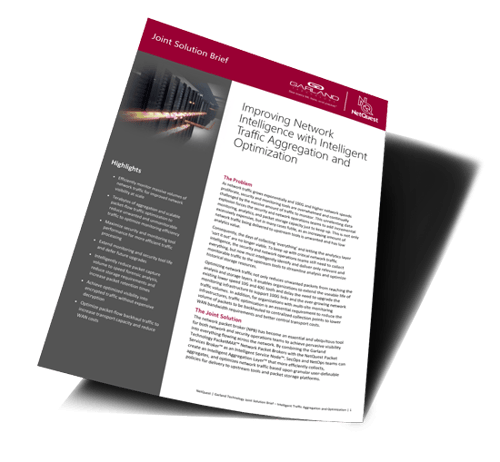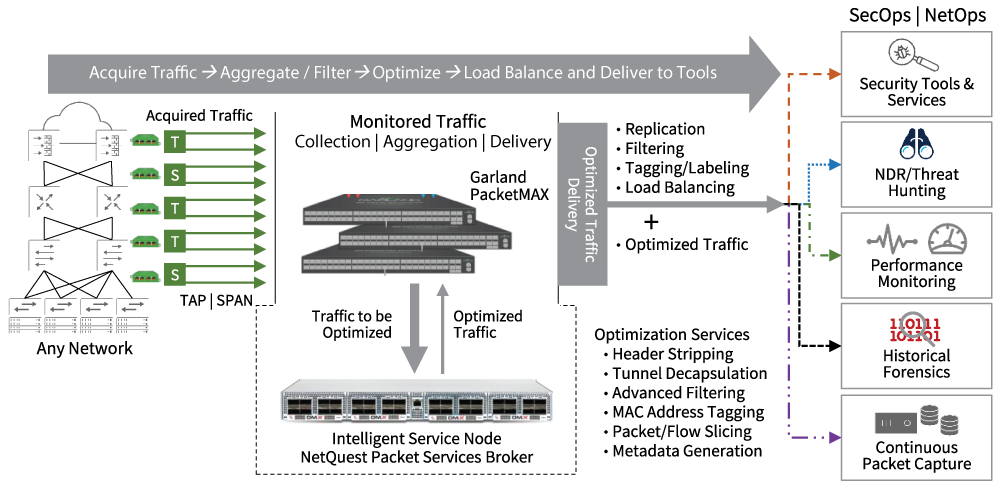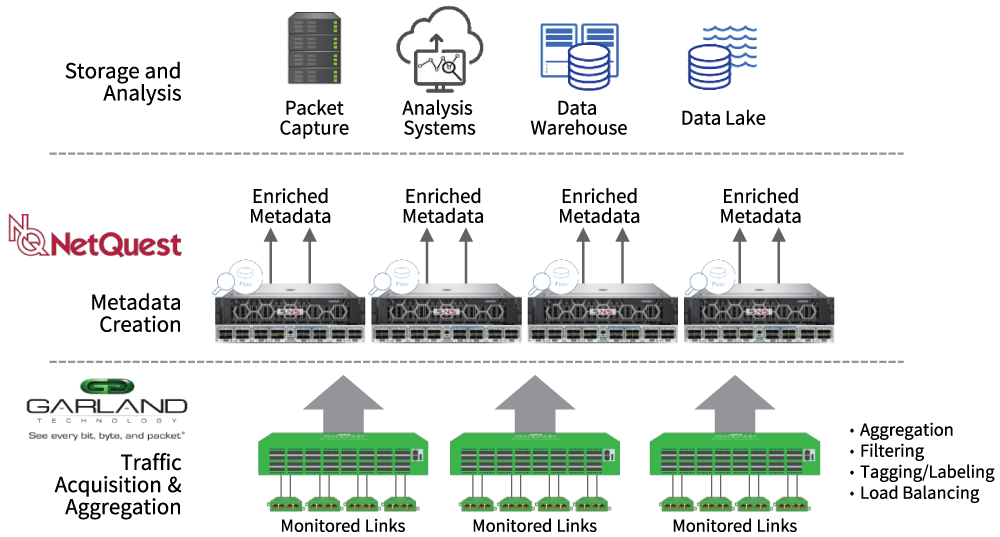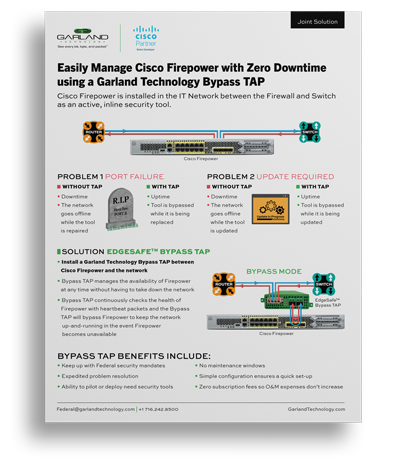
Intelligent
Service Node
The Problem
As network traffic grows exponentially and 100G and higher network speeds proliferate, security and monitoring tools are overwhelmed and continually challenged by the massive amount of traffic to monitor. This unrelenting data explosion forces the security and network operations teams to add incremental monitoring, analytics, and packet storage capacity just to keep up. This is not only excessively expensive, but in many cases futile, as an increasing amount of network traffic being delivered to upstream tools is unwanted and has low analytics value.
Consequently, the days of collecting ‘everything’ and letting the analytics layer ‘sort it out’ are no longer viable. To keep up with critical network traffic intelligence, the security and network operations teams still need to collect everything, but now must intelligently identify and deliver only relevant and monitorable traffic to the upstream tools to streamline analysis and optimize historical storage resources.
Optimizing network traffic not only reduces unwanted packets from reaching the analysis and storage layers. It enables organizations to extend the useable life of existing lower speed 10G and 40G tools and delay the need to upgrade the monitoring infrastructure to support 100G links and the ever-growing network traffic volumes. In addition, for organizations with multi-site monitoring infrastructures, traffic optimization is an essential requirement to reduce the volume of packets to be backhauled to centralized collection points to lower WAN bandwidth requirements and better control transport costs.
The Solution
The network packet broker (NPB) has become an essential and ubiquitous tool for both network and security operations teams to achieve pervasive visibility into everything flowing across the network. By combining the Garland Technology PacketMAX Network Packet Brokers with the NetQuest Packet Services Broker as an Intelligent Service Node, SecOps and NetOps teams can create an Intelligent Aggregation Layer that more efficiently collects, aggregates, and optimizes network traffic based upon granular user-definable policies for delivery to upstream tools and packet storage platforms.
The Intelligent Aggregation Layer off-loads the burden of prioritizing traffic for analysis and storage at the lower cost traffic collection layer by automating the identification and delivery of only relevant packets for analysis and forensic activities. This enables organizations to improve the value and integrity of monitored network traffic to maximize security and network visibility. This, in turn, extends the deployment life of existing tools, thereby delaying the need to add additional resources and storage capacity.
Together the joint Garland Technology and NetQuest Intelligent Aggregation Layer empowers organizations to break-through the performance barriers, packet processing limitations and the high costs of smart packet broker systems. By combining cost-effective Garland PacketMAX platforms with NetQuest ultra-scale packet processing, the combined solution delivers higher capacity with more optimization services at a lower cost than comparable products from alternative vendors.
High-Scale Aggregation and Metadata Creation
The Problem
In today’s hyperconnected world, virtually all communication traverses the network. Because the network interconnects everything, network traffic contains volumes of real-time intelligence that can be harnessed and mined for many important use cases ranging from network intelligence, security monitoring, threat hunting and forensics to lawful intelligence activities.
The challenge is with the proliferation of higher speed desktop, server and network interconnections the amount of traffic crossing networks has reached unprecedented levels and continues to grow exponentially. One hour of network traffic on a single 100G link can reach 45 terabytes. With the growing adoption of higher network speeds and the need to monitor more links to observe east-west traffic, monitoring and security tools are easily overwhelmed by the massive amounts of traffic to ingest and analyze. In addition to the unrelenting data explosion, the complexity of user and server network transactions and everchanging threat landscape means more granular details must be extracted from network traffic to enable effective intelligence and analysis.
Flow-based metadata extracted from network packets overcomes these challenges to enable the efficient observation of all traffic in motion. Unsampled flow metadata is an abstraction of network traffic based upon full packet analysis of the wire data. It provides a rich, lower footprint, high-value data set with critical insights about who is connecting to the network and what is being accessed and shared without the burden of collecting, processing and storing high volumes of packets.
The Solution
The joint Garland Technology-NetQuest solution empowers SecOps and NetOps teams to overcome these challenges by enabling efficient and high-scale monitoring to extract intelligence from virtually any network environment covering hundreds to thousands of network links and millions to billions of flows per second.
The Garland Technology PacketMAX Network Packet Broker acquires network traffic from across an organization’s physical network and cloud footprint and aggregates and delivers network packets to the NetQuest Streaming Network Sensor for intelligent metadata creation at the speed of the network. The Streaming Network Sensor generates deep intelligent metadata that extends beyond basic NetFlow traffic statistics with rich insight into all activities traversing the network for clear and encrypted traffic.
Together the joint Garland and NetQuest Traffic Aggregation and Metadata solution is capable of collecting and translating petabytes of raw network packets into compact and highly efficient metadata containing detailed information about network activity to enable a wide range of operational missions for diverse intelligence activities at scale.
By combining the cost-effective PacketMAX platform with ultra-scale metadata creation, SecOps and NetOps teams can achieve higher capacities with richer metadata without compromising fidelity or service trade-offs empowering organizations to break-through the performance barriers, packet processing limitations and the high costs of smart packet broker systems.
Garland EdgeLens Solution
Garland’s EdgeLens series is an advanced bypass TAP with built-in packet broker functionality that centralizes network traffic, making network tools more efficient by sharing network traffic with monitoring and security tools. EdgeLens provides visibility for a hybrid configuration of an active, inline network device and out-of-band tools, such as LiveAction. EdgeLens provides identical network traffic streams through the active inline device and to the capture engine of LiveAction LiveWire or LiveCapture. The benefits of both devices seeing the same traffic are:
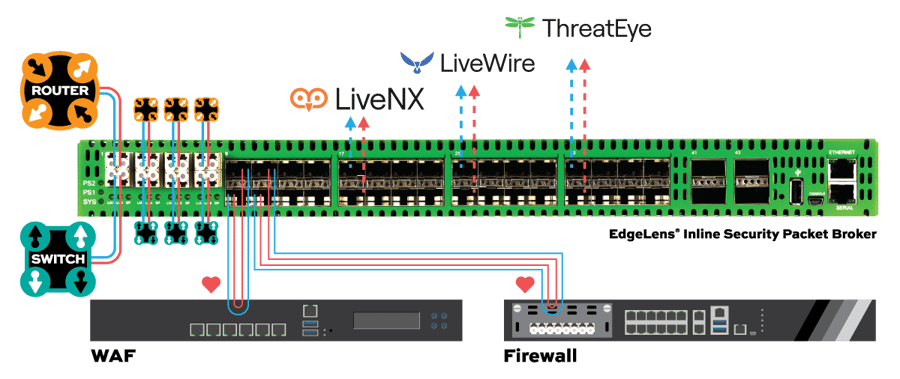
• Correlated data for real-time monitoring and root cause analysis using network packets.
• Historical look back and playback of the network traffic.
• Validating and updating network policy changes and spotting anomalies.
• Network data recording for compliance and security forensics.
• Root cause analysis for application and network related problems.
TAP -> TOOL
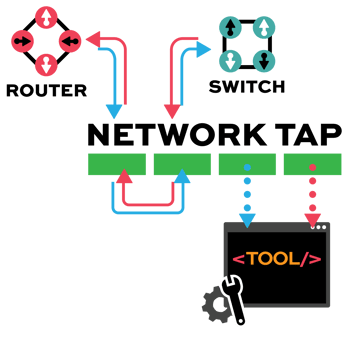
Network TAP Benefits
- Provide complete packet visibility with full-duplex copies of network traffic.
- Ensure no dropped packets while passing physical errors and support jumbo frames without delay or altering the data.
- Support speeds from 10/100M, 1G, 10G, 40G, 100G, and 400G are available in single-mode and multi-mode fiber or copper ethernet.
- Available in Tap ‘Breakout,’ aggregation, regeneration, bypass, and advanced filtering.
- Passive or failsafe – Does not affect the network.
- No IP address or MAC address, and cannot be hacked.
- Intelligent Service Node Joint Solution
- High-Scale Aggregation & Metadata Joint Solution
- How It Works
- Bypass TAP Benefits
- Full PDF Solution Brief
- How It Works
- How It Works
- How It Works
Bypass manages the availability of inline tools, preventing a single point of failure in the network by “bypassing” the device in the event it fails or needs to be updated. Reducing network downtime. Bypass is unique to the other TAP modes, as it is an inline use case not out-of-band.
• Keep up with Federal security mandates
• Expedited problem resolution
• Ability to pilot or deploy need security tools
• No maintenance windows
• Simple configuration ensures a quick set-up
• Zero subscription fees so O&M expenses don’t increase
■SOLUTION EDGESAFETM BYPASS TAP
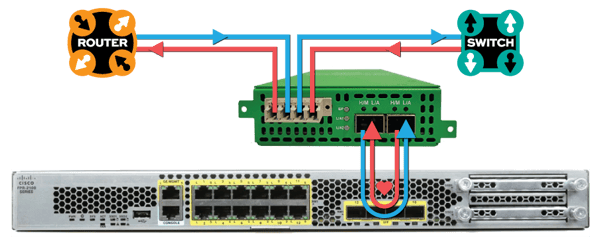
• Install a Garland Technology Bypass TAP between Cisco Firepower and the network
• Bypass TAP manages the availability of Firepower at any time without having to take down the network
• Bypass TAP continuously checks the health of Firepower with heartbeat packets and the Bypass TAP will bypass Firepower to keep the network up-and-running in the event Firepower becomes unavailable
| PROBLEM 1 PORT FAILURE | ||
|
■WITHOUT TAP • The network |

|
■WITH TAP • Uptime • Tool is bypassed while it is being updated |
| PROBLEM 1 PORT FAILURE | ||
|
■WITHOUT TAP • The network |

|
■WITH TAP • Uptime • Tool is bypassed while it is being replaced |





